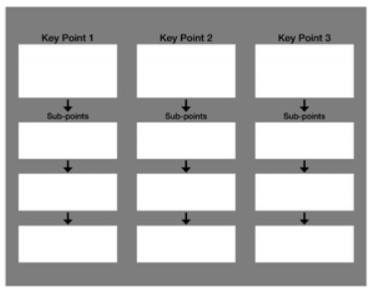This is How to Use the Rule of Three to Be More Persuasive
Back in college, me, and my football buddies had an interesting way of settling ALL our disputes (like who was getting the next round of beers) and making ALL our important decisions (like who was going and taking notes at the 8 am class for all of us). I hope you are not expecting anything earth-shattering because it’s actually pretty ridiculous. The dispute settling and decision-making method we used was none other than the game of rock-paper-scissors. I’ll assume everyone is familiar with it and if not, here’s a quick rundown of what it’s all about.

The point is, the game is based on the 3 shapes above (rock-paper-scissors) and it just wouldn’t be the same if there were any other number of shapes. Having three shapes just makes the game work.
And come to think of it, there are many other things in life that are structured in threes. For example:
 In education: reading, ‘riting, and ‘rithmetic.
In education: reading, ‘riting, and ‘rithmetic.
 How about in entertainment: network acronyms such as ABC, CBS, CNN, HBO.
How about in entertainment: network acronyms such as ABC, CBS, CNN, HBO.
 In law: the truth, the whole truth, and nothing but the truth.
In law: the truth, the whole truth, and nothing but the truth.
 Personal safety: stop, look and listen.
Personal safety: stop, look and listen.
 Sports: NFL, NBA, MLB, NHL, 3 goals in a hat trick.
Sports: NFL, NBA, MLB, NHL, 3 goals in a hat trick.
 Cooking: the 3-minute egg!
Cooking: the 3-minute egg!
 Picnic games: the 3-legged race.
Picnic games: the 3-legged race.
 Threesomes: before you get all hot and bothered, I am referring to groups of 3 individuals such as the 3 Wise Men, the 3 Musketeers, the 3 Amigos, and the 3 Little Pigs.
Threesomes: before you get all hot and bothered, I am referring to groups of 3 individuals such as the 3 Wise Men, the 3 Musketeers, the 3 Amigos, and the 3 Little Pigs.
 Writing and persuasion: the rhetorical triangle, and the rule of three
Writing and persuasion: the rhetorical triangle, and the rule of three
OK, ok…enough examples, I think you get the point.
The one I really want to focus on in this blog post is the rule of three.
What is the Rule of Three?
As we have seen in the introduction above and as Connie Dieken says in her great book Talk Less, Say More: Three Habits to Influence Others and Make Things Happen:
“Triplets are so ingrained in your daily life that you probably aren’t even aware of the pattern. However, subconsciously you’re comfortable with three of anything. It just feels right.” 1
What’s true is that too much of a good thing can overwhelm us and lead to confusion. If we are given 20 options, we don’t know where to begin, but if we are given 3, the bewilderment disappears. The reason being is that scientists have determined that the ideal number of items we can recall in short-term memory at 3 or 4.
So, the question is how can we use the rule of three to our advantage to be more persuasive?
Well, I’m glad you asked!
Let’s now look at three (obviously!) tactics that we can leverage from Dieken’s book using the rule of three.

Three Tactics for Using the Rule of Three to Be More Persuasive
(1) Preload 3 choices
The first tactic is one you can use when you want someone to make a choice in a timely manner. The idea is to preload 3 choices, meaning that you give them three preselected options.
As Dieken says:
“This technique speeds up the dynamics of decision-making. Since the conscious mind loves three, the receiver will feel satisfied that they have plenty of alternatives, but they won’t feel so overwhelmed that they delay or resist making a choice altogether.” 1
You will often see examples of preloading 3 choices in commerce. For example, when I go to the Apple website to compare iPhones they give me 3 choices in a row: the iPhone XR, the iPhone 7 and the iPhone 6. Another example is those infomercials that you see on TV when you are up at 3 am (sorry, couldn’t resist!) with insomnia that makes their products more attractive by using “three easy payments”
(2) Think Narrow and Deep
The second tactic using the rule of three is one that a former boss of mine advised me to use while making a presentation.
Dieken describes it as follows:
“The rule of three works equally well when presenting any type of information that you want people to act upon, beyond just making choices. The narrow and deep formula works in any communication format to avert confusion. Presenting ideas in a narrow and deep way, as opposed to wide and shallow, will cement your ideas and prevent them from getting lost in communication.” 1
There are several ways you can do this:
 In emails, present ideas in bullets or lists of three.
In emails, present ideas in bullets or lists of three.
 If you are on a phone call that has multiple topics, boil it down to three and then begin with the words “three” things, then state them. Why is this so effective? As Dieken says: “The mind latches on to numbers like a bulldog snatches a steak. Announcing a number in advance creates an alert mind.” 1
If you are on a phone call that has multiple topics, boil it down to three and then begin with the words “three” things, then state them. Why is this so effective? As Dieken says: “The mind latches on to numbers like a bulldog snatches a steak. Announcing a number in advance creates an alert mind.” 1
 When presenting, use narrow and deep as it represents the most compelling and powerful structure. The idea is to present three key points along with 3 key subpoints as seen below:
When presenting, use narrow and deep as it represents the most compelling and powerful structure. The idea is to present three key points along with 3 key subpoints as seen below:

I am realistic and do realize that many times we have more than three options to present. However, it is still a great idea to see if you can condense them down to 3 as we are all overwhelmed as it is these days!
(3) Desired Choice First
The last tactic using the rule of three has to do with the ordering of your three items.
It all depends on which of the three you would like them to choose. Dieken recommends always putting your preferred choice first.
The example she uses is when you go buy a mattress. Typically, the salesperson will show you the most expensive one first. The reason for this is that research has shown that after experiencing the best, we have a hard time settling for less.
As Dieken says:
“This tip works not only for selling consumer products, but also in everyday communications. The lesson is this: when presenting ideas or choices in threes, don’t just go linear. Frontload with your desired choice. Your next preferred choice goes in the last position for a strong finish. Your least favorite choice gets buried in the middle.” 1
But What Happens If They Can’t Choose Amongst the Three Options?
Let’s say your friend is over and you offer them three choices of beer—Corona, Bud Light, and Coors Light and they can’t decide. They come back with a wishy-washy “I dunno?”.
The trick, according to Dieken, is to eliminate one, which often works like a charm.
And if they still can’t decide after getting down to two, she recommends just flipping a coin.
If you want my opinion, I say never mind flipping a coin and instead settle it with a good ‘ol game of…rock-paper-scissors!
Until next time, keep using the rule of three, keep playin’ rock-paper-scissors and as always…PYMFP!
–Rick
P.S. If you think we were smart enough to name this blog using the rule of three (Prime Your Pump), we wish! Sadly it’s merely a coincidence!
P.P.S. Wanna know more? Check out the entire book.
Use it or Lose It
Three tactics to use the rule of three to be more persuasive that we discussed above are:
(1) Preload 3 choices.
(2) Think narrow and deep.
(3) Desired choice first.
When to Use It
When you are trying to be more persuasive.
What Do You Think?
Have you ever used the rule of three successfully? How did you do it? Do you think you will use the rule of three if you haven’t before? Please share your thoughts in the comments below!
If you enjoyed this post, it would mean the world to us if you shared it with people you care about via any of the social media platforms below!
Popular Previous Posts:
Dwayne Johnson Quotes: Words of Inspiration from the Rock
This is How to Follow Up to Stand Out From the Crowd
This is How to Stick with Habits Using the Paper Clip Strategy
101 Life Principles We All Know, But Keep Forgetting
References
1 Talk Less, Say More: Three Habits to Influence Others and Make Things Happen by Connie Dieken

I have not used the rule of three except in decorating. The idea is to use three items for display rather than two I.e. three cushions or three books etc. When addressing an audience you are supposed to limit yourself to 15 minutes. If you speak for longer than that you lose the audience’s attention. I am referring to children especially. Thanks for the information. I didn’t realize how many things were grouped in threes.
Hi Eileen, Yeah it’s pretty interesting to see how many things are grouped in three’s and why. Think of phone numbers, grouped into 3, not that we need to remember them anymore! Interesting application in decorating, makes sense. Thanks for reading and commenting! Rick
More threesomes – – –
red – yellow – green
Blonde – brunette – redhead
the 3 Stooges
three coins in the fountain
the 3 faces of Eve
the 3 speed transmission, sometimes a ‘3 on the tree’ Any yes, I have driven these.
The Big Three (from WWII – Churchill, Roosevelt, Stalin)
yes – no – maybe
Three Dog Night
Janus – the Roman god with 3 faces
The Three Ring Sign (other wise known as Borromean rings). You gotta be from New York to understand this. Ask Howie – he will remember.
OK, you get the idea. Next time you are out moseying around, take a look at a railroad trestle bridge. The trestle portion consists of triangular structure, as a triangle cannot be deformed by movement or force, unlike a square or rectangle.
Way back when I was just a pup, a class in public speaking strongly suggested that in an oral presentation that the speaker only should have 3 main points, as that’s all the audience could effectively recall. I found this to be absolutely true while I was in the Air Force. My briefings to generals only had three points or sections. Any more, then the general mighht fall asleep and not remember anything.
With Lockheed, the red-yellow-green method worked in documentation. It would define the best solution, a less desirable alternative, and something totally discarded for whatever reason.
Hi Dave, Great examples!! Interesting on the railroad trestle, will check it out! Totally on the 3 points for oral presentations, similar to what a former mentor told me. Thanks and take care, Rick